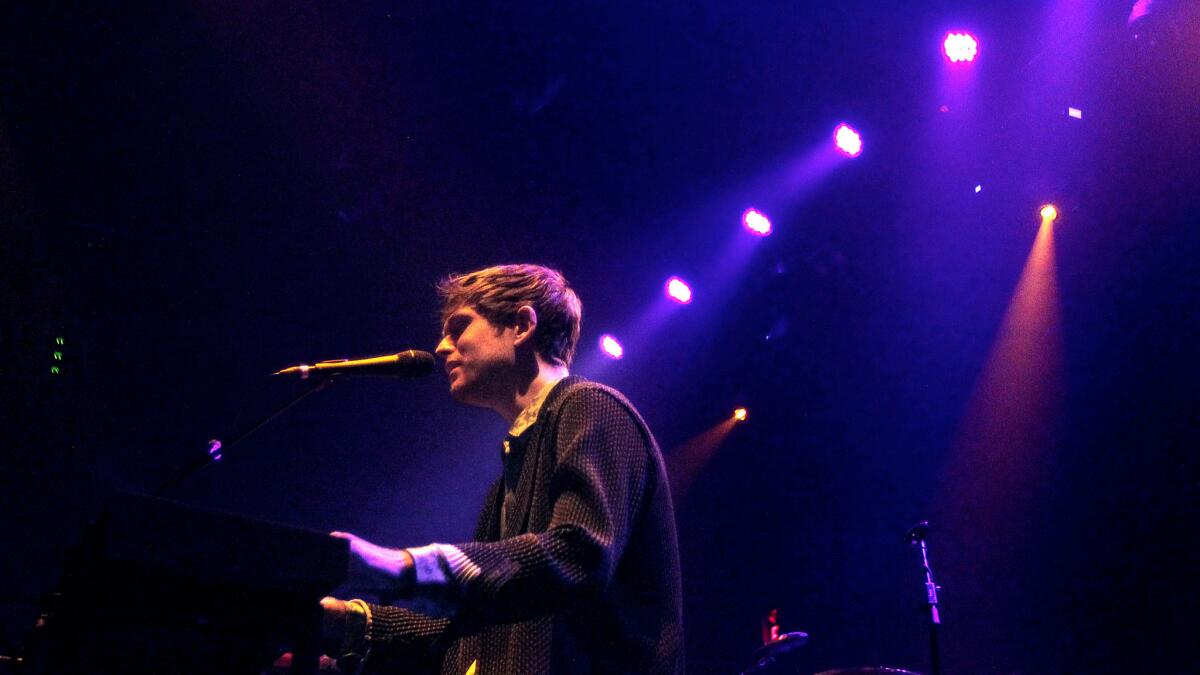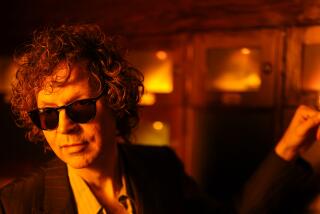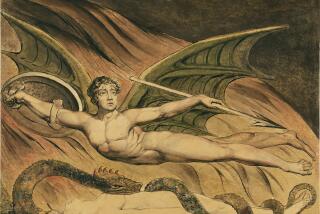After ‘Lemonade,’ James Blake measures his success at the Belasco Theater

- Share via
James Blake makes beautiful music about feeling miserable. In his exquisitely rendered songs, which connect twitchy English dubstep to slow-burn American R&B, the narrator is always lamenting the disappearance of something: love, mostly, but also childhood, community, the long attention spans people had before the iPhone. Each loss is a wound, and each wound requires licking.
Yet misery wasn’t the state Blake was in Monday night at the Belasco Theater, where he played the first show of a brief tour behind his new album, “The Colour in Anything.” Asked by an audience member how he was doing, the 27-year-old singer and keyboardist thought for a second and replied, “I couldn’t be happier.”
Well, sure. Before he released “The Colour in Anything” this month (mere hours after announcing the record was coming), Blake received a huge boost when he appeared as a songwriter and guest vocalist on Beyoncé’s “Lemonade.”
Her endorsement was just the latest in a series of commendations since Blake’s previous album, 2013’s “Overgrown,” won the UK’s prestigious Mercury Prize and inspired Kanye West, in a radio interview, to call Blake his favorite artist. Blake also has been reportedly working with Frank Ocean on the highly anticipated follow-up to that singer’s “Channel Orange.”
So you could understand the contentment he copped to Monday. When Blake looks out at modern pop, from superstars such as Beyoncé and Drake to hip up-and-comers like the indie-soul trio Wet, he sees a world he’s helping to shape. What’s interesting is that his music, whether through a deeper sadness or a commitment to his brand, remains hurt, cloistered, dejected; indeed, “The Colour in Anything” might be his gloomiest — and prettiest — yet, with songs about “a lonely off-white room” and how “we live too long to be so loved.”
At the Belasco, Blake capably reproduced the album’s intricate arrangements with help from guitarist Rob McAndrews and drummer Ben Assiter. “Timeless” layered darting synth lines over a head-nodding beat, while “Choose Me” built methodically to a forbidding climax, like a tidal wave made of visible droplets. For “Radio Silence,” in which Blake sings, “I can’t believe that you don’t want to see me,” the singer used a piece of gear to construct a quick vocal loop, then harmonized with himself — a neat metaphor for the self-obsession that runs through his work.
Later, he brought out two musician friends, Moses Sumney and Connan Mockasin, to add a churchy human touch to the new record’s title track. But more often Blake was drawing out the isolation in his music, as in the anxious “I Hope My Life” and an older song, “Voyeur,” which stretched into a long dance remix whose slithering bass line and industrial-funk groove recalled “Head Like a Hole” by Nine Inch Nails.
Blake closed with “Modern Soul,” a meditative track from “The Colour in Anything” that had him repeating “I want it to be over” probably two dozen times. And though he’d basically said he was enjoying his success, the insistence in his voice made you wonder: Had happiness made him fear losing touch with anguish?
Twitter: @mikaelwood
More to Read
The biggest entertainment stories
Get our big stories about Hollywood, film, television, music, arts, culture and more right in your inbox as soon as they publish.
You may occasionally receive promotional content from the Los Angeles Times.











